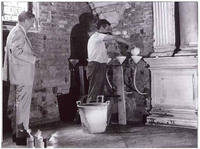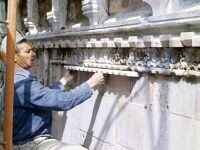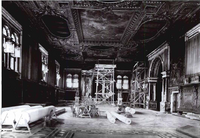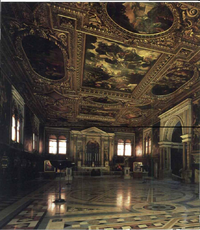World Monuments Fund: Difference between revisions
Created page with "{{Page Institutions |briefdescription='''World Monuments Fund''' (WMF) is a private, international, non-profit organization dedicated to the preservation of important historic..." |
No edit summary |
||
| Line 1: | Line 1: | ||
{{Cleanup}} | |||
{{Page Institutions | {{Page Institutions | ||
|briefdescription='''World Monuments Fund''' (WMF) is a private, international, non-profit organization dedicated to the preservation of important historical architecture and cultural heritage sites around the world through advocacy, education, training, fieldwork, and grants.<ref name="World Monuments Fund Core Programs">{{cite web |url=http://www.wmf.org/content/core-programs|title=World Monuments Fund Core Programs}}</ref> | |briefdescription='''World Monuments Fund''' (WMF) is a private, international, non-profit organization dedicated to the preservation of important historical architecture and cultural heritage sites around the world through advocacy, education, training, fieldwork, and grants.<ref name="World Monuments Fund Core Programs">{{cite web |url=http://www.wmf.org/content/core-programs|title=World Monuments Fund Core Programs}}</ref> | ||
Latest revision as of 22:32, 24 July 2013
| This page may require cleanup to meet Venipedia's quality standards. Please edit the article and fix the problems. |
World Monuments Fund (WMF) is a private, international, non-profit organization dedicated to the preservation of important historical architecture and cultural heritage sites around the world through advocacy, education, training, fieldwork, and grants.[1]
 | |
| Director | Bonnie Burnham |
|---|---|
| Address |
350 Fifth Avenue, Suite 2412 New York, NY 10118 U.S.A. |
| Telephone | (+1)646 4249594 |
| Website | http://www.wmf.org |
History

Originally established on March 15, 1965 by Colonel Gray as the International Fund for Monuments, this private organization was dedicated to the support of worldwide art and architecture conservation; twenty years later, the name was changed to the World Monuments Fund (WMF). The WMF is comprised of over 90 countries including the United Kingdom, France, Portugal and Spain. Both their partners and affiliates play major roles in project development and support.[2] After the flood of 1966 in which most of the artwork and infrastructure of Venice was destroyed, Colonel Gray teamed with Projessor John McAndres of Wellesley College in Massachusetss to assemble a group of individuals who vowed support to the assistance of reconstructing Venice.

After completing their first restoration project– the facade of the Ca’d’Orto, the finest Gothic palace in Venice, the World Monuments Fund continued to sponsor projects in Venice by joining the Private Committees for the Safeguarding of Venice in 1969[3].
Mission
The mission of the WMF is “to preserve important historic buildings, archaeological sites, and works of art, without regard to national boundaries”[4] All of the projects funded by the WMF under Private Committees for the Safeguarding of Venice and UNESCO can be found at this link.
Activities


Dedicated to raising awareness about the importance of safeguarding cultural heritage and the new dangers facing heritage sites, the WMF is an advocate for preservation. The WMF strongly believes that every project is an opportunity to advocate among the public, government agencies, community organizations, and potential donors about the significance of safeguarding cultural heritage.[5] Each year the organization publishes an annual report to inform supporters of the years achievements along with future preservation plans.
World Monuments Watch
Launched in 1996 and published biannually, the World Monuments Watch draws international attention to cultural heritage sites all over the world susceptible to abandonment, defacement, armed conflict, commercial development, natural disasters and climate change. Through this biennial publication the WMF brings together community support for the protection of endangered sites and attracts technical and financial support for the sites.[5] Through programs like the World Monuments Watch, WMF speaks out in support of the protection of sites around the world.
Education and Training
WMF instructs the public, assists with the exchange of information among professionals, while also prepares crafts- and tradespeople in lost arts and modern standards. Site interpretation, international conferences, field schools, our website, and more ensure that safeguarding cultural heritage remains a vibrant field accessible to professionals and the public alike.
Cultural Legacy
Based open the belief of Colonel Gray, WMF’s largest objective has always been preserving the world's architectural and cultural heritage embodied by great buildings and sites, singular monuments that express a specific history of artistic expression or depict a cultural era. This program area offers financial and technical support for preservation of major structures and sites in association with its local partners.
Capacity Building
Assisting local communities shape the governmental, financial, and technical infrastructures to preserve, safeguard, and sustain their cultural heritage is a cornerstone of the WMF’s work. WMF also accumulates teams of international professionals to contribute in designing preservation strategies, conduct pilot projects, improve training procedures and plan for long-term stewardship of the sites in areas where the necessary implements to tackle large-scale preservation projects are lacking.
Disaster Recovery
Preservation undertakings must often respond to extreme circumstances and the WMF remains prepared to diminish the destruction produced by natural or man-made disasters. Providing rapid-response assignments of professionals, damage assessment and assistance in preservation development and implementation; the tools the WMF has developed in times of catastrophe have had comprehensive applications in the field that go far beyond their primary use in emergency response circumstances.
Membership
The WMF is always looking for new members or donations to help support their current projects.
See Also
| ||||||||||||||
References
- ↑ "World Monuments Fund Core Programs". http://www.wmf.org/content/core-programs.
- ↑ "World Monuments Fund Affiliates". http://www.wmf.org/affiliates.
- ↑ "The World Monuments Fund: The First 30 Years, pg.13". http://www.wmf.org/sites/default/files/wmf_publication/World%20Monuments%20Fund_The%20First%20Thirty%20Years.pdf.
- ↑ "The World Monuments Fund: The First 30 Years, pg.10". http://www.wmf.org/sites/default/files/wmf_publication/World%20Monuments%20Fund_The%20First%20Thirty%20Years.pdf.
- ↑ 5.0 5.1 "The Watch". http://www.wmf.org/about-watch. Cite error: Invalid
<ref>tag; name "The Watch" defined multiple times with different content